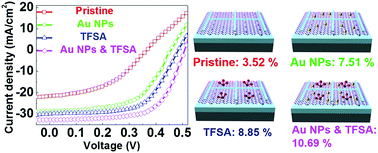Enhancement of efficiency in graphene/porous silicon solar cells by co-doping graphene with gold nanoparticles and bis(trifluoromethanesulfonyl)-amide†
Abstract
Porous silicon (PSi) is an attractive building block for photonic devices, such as solar cells and photodetectors, due to its high surface to volume ratio, low reflection and high optical gain. In this work, PSi is prepared based on metal-assisted chemical etching by varying the deposition time (td) of Ag or Au nanoparticles (NPs) for the etching of Si from 1 to 7 s, thereby controlling the porosity of PSi. The co-doping of graphene with Au NPs and bis(trifluoromethanesulfonyl)-amide [(CF3SO2)2NH] is employed for the first time to enhance the performance of graphene/PSi Schottky-junction solar cells. Co-doping is proven to be very effective for increasing the work function of graphene as well as its electrical conductivity, resulting in efficient separation and collection of photo-induced electron–hole pairs in solar cells. The co-doped graphene/PSi solar cells show a maximum power conversion efficiency (PCE) of 10.69% at td = 5 s, and lose only 5% of the original PCE value after 15 days in air. These results provide a new route for fabricating highly efficient and stable graphene/PSi junction solar cells.



 Please wait while we load your content...
Please wait while we load your content...